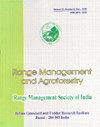Integrated weed control measures for higher yield of Egyptian clover (Trifolium alexandrinum L.)
IF 0.8
4区 农林科学
Q3 AGRONOMY
引用次数: 0
Abstract
Weed management is impeccable for achieving the self-sufficiency in the availability of quality forage. Effective and environmentally sound weed management options are required at this time. Hence, a study was initiated with an objective to study the effect of post emergence (POE) application of propaquizafop and the combination of stale seedbed technique (SST) fb propaquizafop POE (0.075 kg a.i. ha-1) on the weed control and yield of berseem. The results showed that the combination of SST fb propaquizafop POE was superior on berseem plant m-2, grass weed (GW) density and biomass, broadleaf weeds (BL) density and green fodder yield (GFY). However, SST fb propaquizafop POE and propaquizafop POE alone was comparable with the grass weed density and biomass throughout the study. Furthermore, it indicates that POE application of propaquizafop is not an effective option for BL control in berseem. Furthermore, the weed problem is a threat throughout the growth period of the crop. Therefore, applying herbicides (propaquizafop POE at 0.075 kg a.i. ha-1) for grassy weed control or manual weeding at 10 days after each cut, could be a worthwhile option for broad-spectrum weed control and higher yield in berseem.埃及三叶草高产杂草综合防治措施
杂草管理对于实现优质牧草的自给自足是无可挑剔的。此时需要有效和无害环境的杂草管理方案。为此,本研究旨在研究出苗期后施用propaquizafop (0.075 kg a.i. ha-1)与陈化苗床技术(SST)联合施用propaquizafop (0.075 kg a.i. ha-1)对白丝菊杂草控制和产量的影响。结果表明:SST - fb - prozzzzap - POE组合对禾本科植物m-2、禾本科杂草(GW)密度和生物量、阔叶杂草(BL)密度和青饲料产量(GFY)均有显著优势。然而,在整个研究过程中,SST、propaquizafop POE和propaquizafop POE单独与杂草密度和生物量相当。此外,这表明POE应用的适当的afop不是一个有效的选择,以控制BL在北京。此外,杂草问题在作物的整个生长期都是一个威胁。因此,采用0.075 kg a.i. ha-1的除草剂或每次刈割后10天进行人工除草,可能是一种值得选择的广谱杂草控制和更高产量的选择。
本文章由计算机程序翻译,如有差异,请以英文原文为准。
求助全文
约1分钟内获得全文
求助全文
来源期刊

Range Management and Agroforestry
AGRONOMY-
CiteScore
1.50
自引率
62.50%
发文量
25
审稿时长
>12 weeks
期刊介绍:
The Society has been established with the following objectives:
1. To advance the cause of research activity in all aspects of rangelands and to encourage and promote the studies on rangeland, wasteland ecosystems and agroforestry.
2. To provide facilities for seminars and conferences to rangeland researchers, development workers and farmers and to encourage close cooperation with organizations having related aims and interests.
3. To disseminate the knowledge of scientific agriculture and technology for forage and rangeland production, improvement and management.
 求助内容:
求助内容: 应助结果提醒方式:
应助结果提醒方式:


